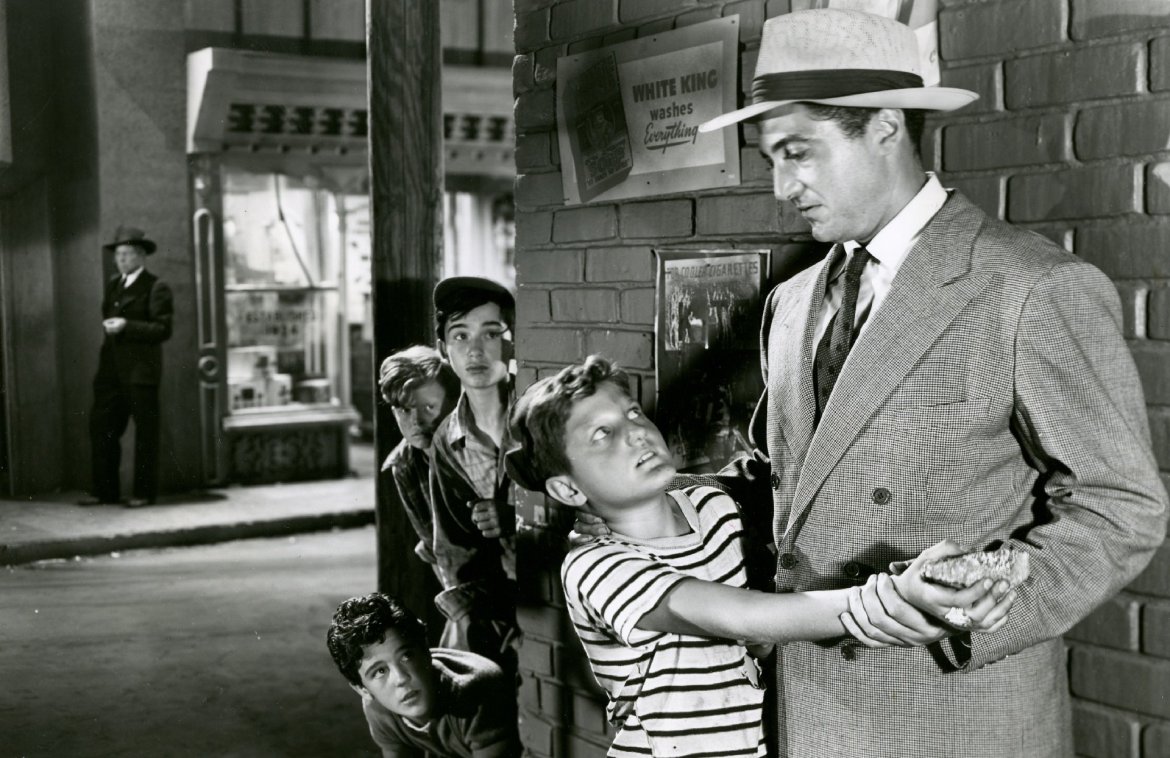History is ultimately written by the winners. This adage is true politically, militarily and even in pop culture. The names and reputations of the Big 5 studios live on. However, so much more happened during this time. Much more happened than the daily goings on at: MGM, 20th Century Fox, Paramount, Warner Brothers and RKO. While a movie like Open Secret is a definite rarity, and not easily found, the poverty row noir is an important part of Hollywood history not only in form, but in its place in culture.
Open Secret follows ex- GI Paul Lester (John Ireland). Recently married and on his honeymoon, he and his wife (Jane Randolph) move in with one of his war buddies as they get their lives in order. He gets more than he bargained for when he stumbles onto a hive of racism and nazism in the post-war, urban neighborhood. John Reinhardt directs the film from a script by Harry Blankfort.
The 1948 poverty-row noir dropped as an incredibly popular entry at the 2019 Turner Classic Movies Film Festival. These immediately post-war noirs play an important role in the tricky political climate of the era.
World War II ended in 1945, a mere three years before this film hit theaters. The United States helped defeat the horrors of facism and nazism overseas, and at the same time, the country found themselves dropped into a period of economic prosperity and conservatism few experienced since before the Great Depression. This is the era which saw the rise of suburbia, supermarkets and the situation comedy. However, 1947 also saw the first round of HUAC hearings (House Un-American Activities Committee) targeting purported “communists” and liberals across the country, particularly those working in the entertainment industry. This is the era of the Blacklist, the McCarthy headings and the Hollywood 10.
Was Communist infiltration really running rampant in Hollywood? What is the hallmark of one of these “subversives”? So many of the noirs during this politically tenuous period saw their filmmakers not only targeted by the committee, and largely drummed our of Hollywood. Open Secret writer Harry Blankfort was one of those blacklisted. Narratively, the feature is very much like its contemporaries. The plot doesn’t revolve around the overthrow of the Capitalist structure or the overthrow of the American way of life. The movie deals with equality and questions of racism on the home front. After all, the United States just finished fighting targeted Nazi extermination of groups across Europe. Yet, while the homogenized ideal we see in 1950s mainstream popular culture took hold, so many creators who dared to ask questions (or strayed from the norm) were quickly blacklisted.

The target of the racist aggression in Open Secret is (Jewish) photography store owner Harry Strauss (George Tyne), a man who the Lester’s quickly befriend. Throughout the course of the film, his store window is almost busted out, his tires are slashed and he faces harassment from the local population. This is common in the movies which found themselves connected with the Blacklist. Crossfire deals with Jewish discrimination on the home front. Salt of the Earth deals with the rights of Mexican migrant workers. On the Waterfront deals with union politics and violence among New York City dock workers.
Screenwriter Harry Blankfort’s filmography only boasts 23 credits, most of which largely unknown to the most except hardened of film historians. A versatile writer, his features span the genres, taking in musicals, comedy, noir and action. According to the writer’s 1993 obituary, he moved out to Hollywood in 1936. In between screenplays, Blankfort found himself heavily involved in the theater, heading the Hollywood Theater Alliance by 1939. His blacklisting came in 1951 when he refused to testify in front of HUAC. With his showbusiness career over, Blankfort transitioned into a variety of fields, making a name for himself in public relations and later education. He’s just one of a number of men and women who saw their livelihoods ended by a shameless exercise of political power. The House Un-American Activities Committee continues to be a powerful and (spookily timely) example of political panic and paranoia in American history.

Overall, while Open Secret does film struggle with contemporary relatability because of its very poverty-row like appearance, the script and story-telling is by far and away the strength in Open Secret. Blankfort’s script crafts a sharp, slow-burning sense of tension as Paul struggles to figure out not only what happened to his missing friend, but also what’s going on in the neighborhood. The incorporation of photographs as a plot device is an interesting one. Through this, Blankfort finds a way to visually convey an abstract concept like Nazism. At the time of the movie’s release, the United States was only a few years removed from the Holocaust and the images of anti-Semitic graffiti and smashed up windows would have hit incredibly hard, conjuring memories of the still recent horror.
While much of Hollywood’s legacy is defined by the work of the five major studios, there are decades of movies coming out of the dozens of smaller studios which not only crafted interesting and intelligent stories, but hold important places in the pantheon of Hollywood history. Open Secret is one of these small features which may feel like a blip on Tinseltown’s radar, but in truth demonstrates the importance of not only film history, but film preservation.
Stay tuned for continuing coverage from TCMFF!

